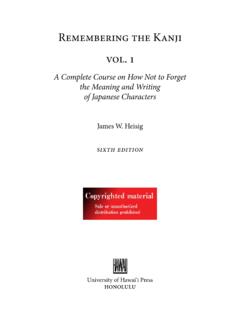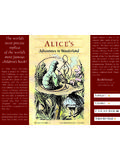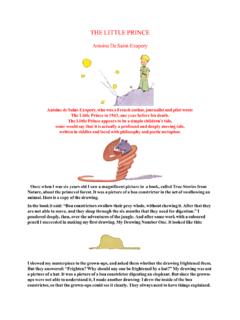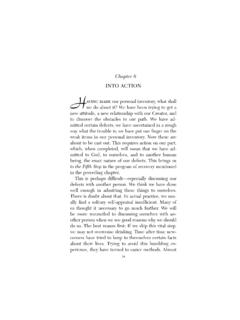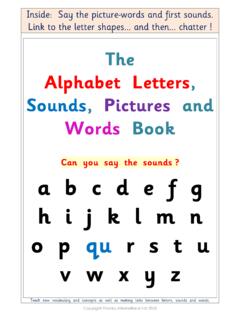Transcription of remembering simplified hanzi – book 1
1 remembering simplified hanzi book 1by the same authorsRemembering Traditional hanzi : How Not to Forget the Meaning and Writing of Chinese Characters, book 1. Honolulu: University of Hawai i Press, 2009 remembering Traditional hanzi : How Not to Forget the Meaning and Writing of Chinese Characters, book 2. Honolulu: University of Hawai i Press, 2012 remembering simplified hanzi : How Not to Forget the Meaning and Writing of Chinese Characters, book 2. Honolulu: University of Hawai i Press, 2012 remembering simplified HanziHow Not to Forget the Meaning and Writing of Chinese CharactersBook 1 James W. HeisigTimothy W. Richardson University of Hawai i Press honoluluCopyright 2009 University of Hawai i PressAll rights reserved, including the right to reproduce this book or portions thereof in any form without the written permission of the in the United States of America14 13 12 11 10 09 6 5 4 3 Library of Congress Cataloging-in-Publication DataHeisig, James W.
2 , 1944- remembering simplified hanzi : book 1 : how not to forget the meaning and writing of Chinese characters / James W. Heisig ; Timothy W. cm. Includes indexes. ISBN 978-0-8248-3323-7 (pbk. : alk. paper)1. Chinese language-- simplified characters. 2. Chinese language--study and teaching. I. Richardson, Timothy W. II. Title. III. Title: How not to forget the meaning and writing of Chinese characters. 2008 dc22 2008032998 The typesetting for this book was done at the Nanzan Institute for Religion and of Hawai i Press books are printed on acid-free paper and meet the guidelines for permanence and durability of the Council on Library .. 1 Uprooting Biases about Character Learning .. 2A Short History of the Course .. 6 The Basics of the Method .. 11 The Design of this book .. 12 Concluding Comments.
3 14 Acknowledgments .. 15 Stories (Lessons 1 12) .. 17 Plots (Lessons 13 19) .. 125 Elements (Lessons 20 55) .. 191 Indexesi. Hand-Drawn Characters .. 375ii. Primitive Elements .. 389iii. Characters by Number of Strokes .. 392iv. Character Pronunciations .. 401v. Key Words and Primitive Meanings .. 410vIntroductionThe aim of this course is to help you teach yourself, as quickly and efficiently as possible, the meaning and writing of the 3,000 most com-monly used Chinese characters. The course is intended not only for beginners, but also for more advanced students looking for some way to systematize what they already know and gain relief from the constant frustration of forgetting how to write the characters. By showing how to break down the complexities of the characters into their basic elements, assigning meanings to those elements, and arranging the characters in a unique and rational order, the method aims to make use of the structural properties of the writing system itself to reduce the burden on 55 lessons that make up book 1 cover the 1,000 most commonly used characters in the Chinese writing system, plus another 500 included either because they are needed to preserve the logical ordering of the material or because they are especially easy to learn at this early stage.
4 book 2 will add another 1,500 characters and has been arranged so that those who wish to do so may study the two volumes at the same time. Together they comprise 3,000 characters all of them selected on the basis of the frequency with which they appear in written Chinese. What you will not learn in either of these volumes is how to pronounce any of these characters or how to combine them to form new words. Since this breaks with conventional methods for teaching char-acters, it is important that you understand the rationale behind the approach before setting students approaching Chinese from a mother tongue written with an alphabet, the characters represent a forbidding obstacle, one that involves the memorization of thousands of complex configurations, each of which has to be tethered to a particular sound and a particular meaning or function.
5 Focusing for the moment just on what is involved in trying to commit the written forms to memory, imagine yourself holding a kaleidoscope up to the light as still as possible, trying to fix in memory the particular pattern that the play of light and mirrors and colored stones has created. Chances are, your mind is unac-customed to processing such material and it will take some time to organize the pattern for retention and recall. But let us suppose that you succeed after ten or fifteen minutes. You close your eyes, trace the pattern in your head, and 12 | introductionthen check your image against the original pattern, repeating the process until you are sure you have it committed to memory. Then someone passes by and jars your elbow. The pattern is lost forever and in its place a new jumble appears.
6 Immediately your memory begins to scram-ble. You set the kaleidoscope aside, sit down, and try to draw what you had just memorized, but to no avail. There is simply nothing left in memory to grab hold of. The characters are like that. One can sit at one s desk and drill a number of characters for an hour or two, only to discover on the morrow that when something similar is seen, the former memory is erased or hopelessly confused by the new information. No wonder learners begin to think that they simply don t have a good memory for characters, or decide that learning to write char-acters is not so important many cases failure to retain what has been learned has much less to do with a lack of ability than with the lack of a method of learning adjusted to the circumstances of the learner. Of course we forget, and some of us forget more than others.
7 But some of this forgetting is due to a simple misuse, even abuse, of our powers of memory, and is therefore preventable. The first step to preven-tion is to break with certain preconceptions about learning to write biases about character learningOne bias circulating among teachers and students of the Chinese language is that a character s meaning, pronunciation, and writing need to be learned at the same time. Chinese textbooks typically include all three bits of information for each character or compound term as it is introduced, in addi-tion to supplying details about grammatical function and examples of usage. Of course, these things are important, but to have to learn them all at once places an unreasonable burden on memory. Little wonder that the brain slows down or grinds to a complete Chinese themselves are not faced with this problem.
8 As children, they are exposed first to the spoken language, learning how to associate sounds with meanings. When the time comes to learn how to read, they already have at their disposal a solid basis of words whose sounds and meanings are familiar to them; all that remains is to associate those words with written forms. Doing so opens them to printed texts, which, in turn, helps them assimilate new words and characters. Those of us who come to the language as adults can gain a simi-lar advantage by tying each of the character forms to a particular unit of pro-nunciation and meaning, a key word in English, that we already know. Before you dismiss the idea of affixing English words to Chinese characters out of hand, consider this: all the Chinese dialects, no matter how mutually unintelligible they are when spoken, use the same characters for writing.
9 These introduction | 3characters convey the same meaning, no matter how they are pronounced. What is more, when the Japanese use Chinese characters, they assign them still other pronunciations. In other words, there is nothing in the nature of a character dictating that it must be verbalized one way or another. Unlike students coming to Chinese from an alphabetically written language, the Japanese already know the meaning and writing of a great many of the characters. By the time you finish this course, you will be in a position similar to theirs. Of course, you will eventually need to learn Chinese pronunciations, just as Japanese students do. But adding difficult and unfamiliar sounds to a solid knowledge of character forms is a much more manageable task than trying to memorize meaning, pro-nunciation, and writing all at the same some separation of learning tasks seems reasonable, then why not acquire a sizable vocabulary of Chinese pronunciations and meanings first as the Chinese children do and then pick up writing later?
10 After all, oral language is the older, more universal, and more ordinary means of communication. Hence the bias that if anything is to be postponed, it should be the introduction of the writing system. The truth is, written characters bring a high degree of clarity to the multiplicity of meanings carried by homophones in the spoken language. For example, even an ordinary pocket dictionary of Mandarin lists some 60 characters that are pronounced yi in one or another of its tonal variants, with at least 30 distinct characters in the fourth tone alone. Each of these charac-ters carries its own meaning or meanings, which the simple syllable yi of itself cannot communicate. Beginning with characters and their meanings greatly reduces this idea that writing should come after speaking is bolstered by another, more pervasive bias: the writing of characters is the most complex part of the language to learn.
